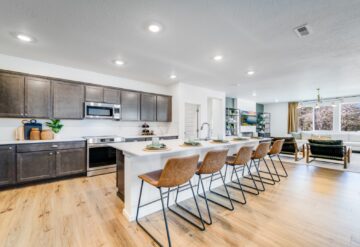As more adult children continue to return home, and others that never left the nest in the first place, Gen X homebuyers are being influenced into purchasing multigenerational homes like Lennar’s Next Gen® The Home Within a Home®. Learn more about multigenerational living in this The Day article by Day Marketing.
Members of Generation X are the most likely to buy a multigenerational home, according to a recent report by the National Association of Realtors. This trend is a result of adult children in the generation who have moved back in with their parents or never struck out on their own.
While 12 percent of buyers purchased a multigenerational home between July 2017 and June 2018, the share stood at 16 percent among Gen Xers (defined as ages 39 to 53). The share was also higher among other older generations, including 15 percent of younger boomers (ages 54 to 63) and 13 percent of older boomers and the Silent Generation (ages 64 to 72 and 73 to 93, respectively).
Younger buyers were more likely to say that they purchased a multigenerational home in order to live with an aging parent and help take care of them. Thirty-one percent of younger boomers who bought a multigenerational home said adult children or relatives had moved back into the household, while 27 percent of these Gen X buyers said their adult children never left home.
“The high cost of rent and lack of affordable housing inventory is sending adult children back to their parents’ homes either out of necessity or an attempt to save money,” said Lawrence Yun, chief economist at the National Association of Realtors. “While these multigenerational homes may not be what a majority of Americans expect out of homeownership, this method allows younger potential buyers the opportunity to gain their financial footing and transition into homeownership. In fact, younger millennials are the most likely to move directly out of their parents’ homes into homeownership, circumventing renting altogether.”
The finding was part of the National Association of Realtors’ 2019 Home Buyer and Seller Generational Trends study. The report is based on 7,191 responses from people who recently purchased a primary residence.
Buyer characteristics
One-third of all buyers were purchasing their first residence. Millennials made up the largest share of buyers at 37 percent, including 26 percent of older millennials (ages 29 to 38) and 11 percent of younger millennials (ages 21 to 28).
Yun said the division of the millennial generation was necessary because younger millennials have now eclipsed the Silent Generation, who accounted for just 7 percent of buyers. He also noted that younger millennials tend to purchase smaller, lower-priced homes, while the median price of a home purchased by older millennials ($274,000) is nearly $100,000 higher.
“Older millennials are now entering the prime earning stages of their careers, and the size and costs of homes they purchase reflect this,” said Yun. “Their choices are falling more in line with their Gen X and boomer counterparts.”
Gen X respondents had the highest median household income at $111,100. They also bought the largest and most expensive homes at a median of 2,100 square feet and $277,800.
Sixty-three percent of buyers were married, while 18 percent were single females, 9 percent were single males, and 8 percent were unmarried couples. Younger millennials were most likely to purchase a home as part of an unmarried couple, with 20 percent describing themselves this way.
Home choices
Buyers under the age of 63 were most likely to say they wanted to buy a home of their own. Older buyers were more likely to say they wanted to be closer to friends or family, downsize to a smaller residence, or purchase a home for retirement.
Eighty-six percent of buyers bought an existing home, and were most likely to prefer the better price or value offered by these properties. Among new home buyers, younger buyers wanted to avoid renovations or repairs while boomers were more likely to want to choose or customize their home features.
The typical buyer bought a home with a median of 1,900 square feet. Younger millennials bought the smallest homes, with a median size of 1,600 square feet, while Silent Generation buyers bought homes with a median size of 1,700 square feet.
Across all generations, suburbs were the most popular neighborhood among buyers, followed by rural areas. Millennials were most likely to favor urban neighborhoods, though just 17 percent bought a home in one.
Commutes had a greater influence on younger buyers, with 71 percent of younger millennials and 61 percent of older millennials saying it was important that the neighborhood be convenient to their workplace. While heating and cooling costs were the most important environmental consideration among all buyers, younger buyers were more likely to be concerned about the distance required to drive to work.
Continue Reading the Full Article HERE.




